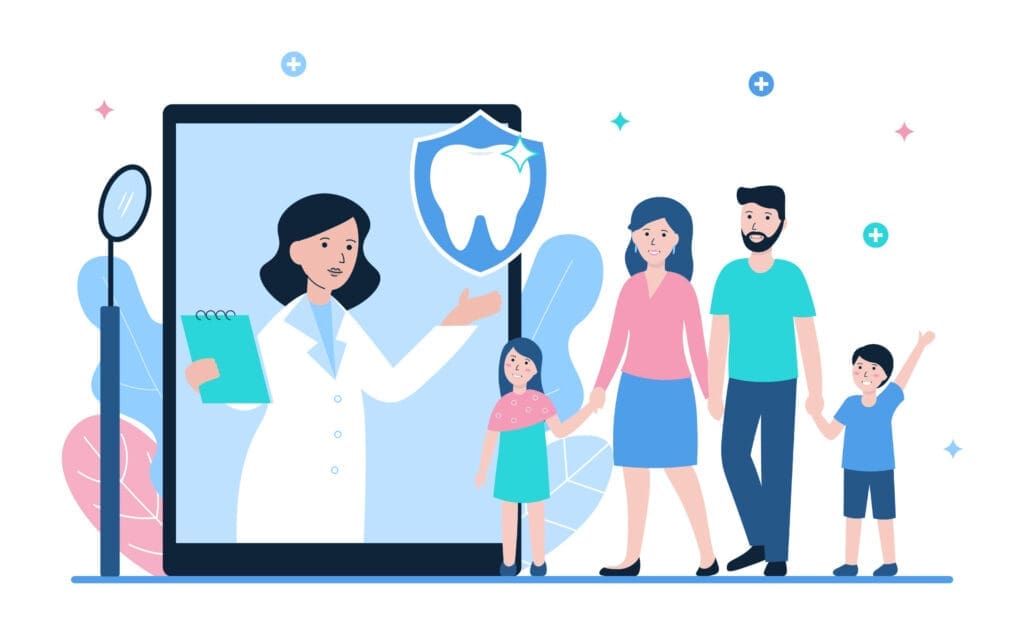 Q: My marketing isn’t working! We’ve tried a few different types of marketing, but we’re not seeing enough new patients from them.
Q: My marketing isn’t working! We’ve tried a few different types of marketing, but we’re not seeing enough new patients from them.
A: Thank you for the question! And this is a common problem.
In most cases, when this happens, our instinctual reaction is: “The marketing company I hired isn’t doing their job” or “This type of marketing just doesn’t work in my area. ” And believe me, I understand. But there are actually many other reasons why your marketing may not be getting the desired results.
We’ve written about many of these on the MGE blog already—things like how your front desk answers the phone, scheduling, internal marketing, word-of-mouth referrals, website design, tracking return-on-investment, seeing too many “unqualified” patients, and more. You can read more of those articles here.
But, to make things simple, in this post, I want to focus on four of the most common marketing/new patient problems and what to do about them. And with that, we’ll start with number 1.
1. You’re relying too much on one type of marketing
![]() There is no single magic bullet for marketing. There’s no “This ONE thing will solve all your marketing issues!”
There is no single magic bullet for marketing. There’s no “This ONE thing will solve all your marketing issues!”
(Related: Comparing the Cost of 9 Dental Marketing Strategies)
Marketing works best when you’re doing multiple things that all work together. Website, online reviews, search-engine optimization, ads, social media, postcards, signage, internal marketing, referral programs, billboards, etc. You don’t necessarily need to do all of these things, but you MUST have a coordinated approach.
If you put all of your marketing eggs in one basket—it’s not only less effective, it’s dangerous! If for whatever reason anything happens to this one marketing avenue, you’re hosed.
Example: I remember one dentist that got virtually all of their new patients from one large corporate office nearby that gave their employees great insurance. The practice was thriving and life was great…until the corporation relocated. All of a sudden they had no avenue for acquiring new patients and no idea where to start.
And another: Dentist was getting fantastic results with Facebook ads. They were the first dentist in their town to start using Facebook ads—and since it was going so well, they devoted the entire marketing budget to it. Then a new dentist moved into town and started competing on Facebook and a few other local dentists caught on, too. Their numbers crashed because Facebook was responsible for the majority of their new patients.
The lesson: have a coordinated, multi-faceted new patient strategy!
2. Internally (within the office), you’re not doing everything possible to get more referrals and support your external marketing
Yes, it’s okay to spend money on marketing, but I want to get the absolute maximum bang for my buck, and I don’t want to spend cash on something that I could get for free.
There are many internal actions you can do for free that will generate new patients. There are also several actions, that when not done, will sabotage your external marketing.
 At the MGE New Patient Workshop, we provide systems to run these things effectively and get your staff on board. I highly recommend you attend, because you get a TON of value from these free internal systems as well as guidance on how to get great ROI from paid external marketing. it comes with a money-back guarantee within 6 months of attending the course so it’s a no-brainer!
At the MGE New Patient Workshop, we provide systems to run these things effectively and get your staff on board. I highly recommend you attend, because you get a TON of value from these free internal systems as well as guidance on how to get great ROI from paid external marketing. it comes with a money-back guarantee within 6 months of attending the course so it’s a no-brainer!
(Related: 6 Ways to Get More New Patient Referrals)
That said, here are a few simple examples of what I’m referring to:
- Trouble with answering the phones and scheduling new patients effectively. Read more here.
- Not getting patients to leave online reviews on Google, Yelp, etc. Read more here.
- Sporadically (or not at all) asking for word-of-mouth referrals and scheduling patients’ family members. This should be done MULTIPLE TIMES EVERY DAY. Read more here.
- Improving patient retention with your recall patients (more active patients = more potential word-of-mouth referrals). Read more here.
- Increasing case acceptance with new patients. You may wonder if or how this affects new patients… it does! A lot. Read more here.
You really NEED to be focusing on maximizing performance in all of the things I mentioned above.
For example: Let’s say you are doing Google ads and paying on average about $300 per new patient.
- Improve your receptionist’s phone skills to double the appointment rate (completely possible)—now that number is down to $150 per new patient.
- Schedule just one (easy to do more) of the patient’s family members or friends—now it’s down to $50 per new patient.
- Present the entire treatment plan they need (not just what insurance covers) and get it accepted—you just doubled your new patient value.
- Cut your patient attrition rate in half by retaining them better in hygiene (also completely possible)—you just doubled your new patient value again.
3. You’re skimping on your marketing
 I know it’s tough to say, “My marketing isn’t working, so I should spend MORE on it!” And I certainly don’t want you to dump more money into ineffective marketing—you should be tracking return-on-investment and ensure it’s worthwhile before spending more on it. (See this article on tracking ROI for more on that.)
I know it’s tough to say, “My marketing isn’t working, so I should spend MORE on it!” And I certainly don’t want you to dump more money into ineffective marketing—you should be tracking return-on-investment and ensure it’s worthwhile before spending more on it. (See this article on tracking ROI for more on that.)
I also want to make sure you’re doing all the free and/or low-cost actions you could be doing internally to maximize new patients as I discussed above.
But having said all that, external marketing does cost money. It’s a major business expense that all businesses must carry. You need to have a proper marketing budget.
In dentistry, we tend not to budget much toward marketing. It’s considered a “luxury” instead of a necessity. I don’t know why this is, maybe an old school mentality that, “If I hang up a shingle, patients will come,” or “We’re doctors, not businesspeople,” but the reality is that all businesses need to market their products/services.
What your marketing budget should be depends on where you’re at, what your goals are, how aggressively you’re trying to grown and whether you’re in an expansion phase (adding new ops, building a new office, etc) or a maintenance phase. If you’re in an expansion phase, you may even go as high as 10% + of your gross revenues on marketing.
And this concept of “skimping on your marketing” can apply to individual marketing campaigns. I’ve seen dental offices send a few hundred postcards out and only see one or two new patients from it, and then decide it doesn’t work. Well, of course the office isn’t flooded with new patients! Direct mail is a numbers game. You probably need to send out a couple thousand postcards for consecutive months to see a noticeable number of new patients from it.
4. You’re not actively monitoring each marketing campaign and its results
 I’m not going to rehash this whole point here, because we just had a great article about this from our Marketing Director, Adam Mortimer, a couple weeks ago.
I’m not going to rehash this whole point here, because we just had a great article about this from our Marketing Director, Adam Mortimer, a couple weeks ago.
But the point is, don’t judge the effectiveness of your marketing by feeling—e.g. “I feel like we didn’t see many new patients this month,” or “Nobody mentioned Facebook when they came in here.”
You need to know how many phone calls you received, how many new patients scheduled, and how much income you made as a result of a campaign so you can plan and budget intelligently going forward.
I’ve even seen it happen where a dentist thought they needed more new patients but when we actually looked at their numbers, they were seeing plenty of new patients already and the real problem was that they’re recall program had declined (easy fix). Since they didn’t actually look at the numbers, they just assumed they needed to change their marketing to see more new patients.
5. Nobody is in charge of marketing/new patients
 When I meet a new client here at MGE, I’ll ask them: “In your practice, whose job is it to run the marketing and get new patients?”
When I meet a new client here at MGE, I’ll ask them: “In your practice, whose job is it to run the marketing and get new patients?”
Usually, they answer, “Oh…hmm…I guess it’s mine?”
The fact that they don’t know, and it’s never been assigned to anyone, is a problem.
Marketing is an important part of any business. All medium to large businesses have a big department dedicated entirely to marketing, and it’s usually one of the most important departments in the company.
So, if you don’t know whose job it is, I can guarantee you that you’re not dedicating enough time and resources to it.
In a small office, maybe it is the owner-doctor’s job. But seeing as it does require some time and attention, it’s usually best to assign it to someone else if possible.
At any rate, someone needs to be ensuring all avenues are being done properly and are producing results, that any external company you hired is doing their job, that any problems are resolved quickly, and that internal actions are being done to augment external advertising.
If you need help figuring out who to assign this job to or how to organize this properly, schedule a free consultation with us here. We’d be happy to help.
I hope this post was helpful! If you have any other questions for me, email me at SabriB@mgeonline.com.



No Comments
Be the first to start a conversation